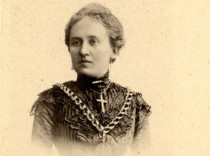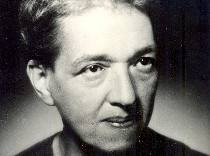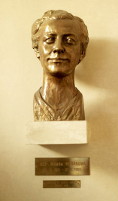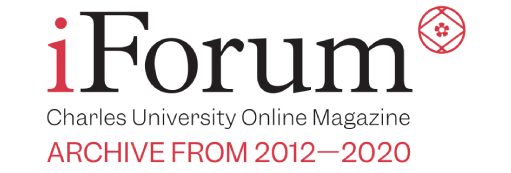Claire Martin • foto: Archiv UK, Geography libary Faculty of Science, red. • 4 April 2013
Calendar - Women in History of Charles University
Charles University celebrates the year of the woman with the creation of a calendar honouring thirteen individuals who have contributed to the academic world and beyond.
In 1890 the first Czech grammar school for girls, Minerva, was established by the librettist Eliška Krásnohorská, who commences the calendar year as the first female to receive an honorary doctorate of Charles University in 1922.

Zoologist Marie Zdeňka Baborová-Čiháková, the first woman to receive a doctoral degreeErstwhile, Czech girls were educated at home. Since 1774 it was recommended that children from the ages of 6 to 12 should attend primary school and this would become compulsory in 1805. Girls attended primary schools from 1780s, first in separate, girls-only classes and then in co-educational ones. They could also gain access to education through voluntary clubs such as the American Ladies’ Club founded by Vojta Náprstek in 1865.
The Charles-Ferdinand University did not admit women until 1897. Therefore, women had to receive their university education elsewhere, with the first Czech female doctors graduating in 1880 from Zurich. These diplomas, however, would not be recognised by Austria-Hungary so many had to seek work abroad.
Throughout time women have practised medicine often in their own towns and villages or through their position as nuns; there was a woman doctor, Trotula, at the Medical School in Salerno in the 11th or 12th century. Renaissance thinking undermined traditional approaches to medicine which was often a feature of female care. What’s more, women were gradually usurped by male practitioners in midwifery. Sex was but a biological barrier as demonstrated by the career of Doctor James Barry. From 1813 to 1864 he was a reputed surgeon in the British Army. When an autopsy revealed he was a woman the war department and the medical association were so embarrassed that the findings were hidden and Doctor Barry was buried as a man. No such disguise was necessary for Anna Honzáková who would be the first openly female doctor to graduate from Charles-Ferdinand University in 1902.

Julie MoschelesováFebruary features the zoologist Marie Zdeňka Baborová-Čiháková, the first woman to receive a doctoral degree at Charles-Ferdinand University, Faculty of Arts in 1901. In March we marvel at the life of Julie Moschelesová who achieved associate professorship of geography in 1934 gaining European acclaim in her field. Ousted from the faculty in 1939 because she was Jewish, she would spend most of the war in Australia working as a geographer in the military services of the Dutch East Indies. Spring shows Gerty Theresa Cori who was awarded the Nobel Prize in 1947 for physiology and medicine. May displays Ludmila Matiegková, an Egyptologist. In June we learn of Albína Dratvová, the first associate professor at the Faculty of Science of Charles University. Her book, Deník (Diary), published posthumously in 2008 describes the obstacles and possibilities which the first generation of female scientists had to combat. Philosopher Jaroslava Pešková is the face of October, the first vice-dean of Charles University, Faculty of Arts post revolution 1989. In November we remember Jaroslava Moserová who was a doctor, an associate professor, writer, translator, diplomat and politician. In December we celebrate Dana Kalvodová, a pioneer in the discipline of Asian theatre. Summer shows Milada Paulová, a Byzantine scholar, who in 1939 would become the first female professor of Charles University. The diverse disciplines in which these women excelled illustrate a determined departure from studies previously deemed suitable for their sex.

Milada Horáková would become a victim of the rising communist powerAugust’s Milada Horáková was expelled from school for partaking in an anti-war demonstration in 1918. While studying law in interwar Czechoslovakia she joined the Women’s National Council concentrating on female emancipation. Later, she became a member of the Czechoslovak National Socialist Party, participated in the World War Two resistance movement, and would lead the Women’s Council after the war. However, Milada Horáková would become a victim of the rising communist power. The feminist movement had been a principally bourgeois initiative; supporting first Czechoslovakian president Tomáš Garrigue Masaryk and democratic institutions. After the communists gained power Milada Horáková was involved in the composition of laws which benefitted women. However, she became target of suspicion and was executed in June 1950.
Another important female introduced in the calendar who confronted totalitarianism is Růžena Vacková, a professor of classical archaeology, who was imprisoned by the Nazis for supporting the resistance. Undeterred, she was involved with anti-communist student demonstrations after the war. In 1952 she was sentenced to 22 years for espionage and attempted treason. During her incarceration she lectured fellow prisoners on philosophy and art history.
In 1897 women gained access to higher education at Czech universities. Commencing with the Faculty of Arts, three years later women could train as doctors, and by the end of WWI women were able to become lawyers. Today, the overall majority of students at Charles University are female. However, their presence is less notable in the academic hierarchy, with women comprising only sixteen per cent of professors. This year, as we mark exam dates on the calendar or count the days until summer, we remember thirteen women who helped make this possible.
